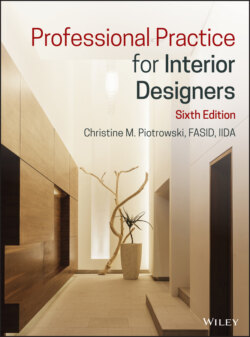Читать книгу Professional Practice for Interior Designers - Christine M. Piotrowski - Страница 10
PREFACE
ОглавлениеThe interior design profession continues to be impacted by numerous challenges. Technology enhancements, various uses of the Internet, and social media platforms force practitioners to find new ways to work and market. Economic highs and lows are always providing opportunities or threats to any size business. The Internet allows even the sole practitioner the opportunity to work internationally. The sophistication of the client creates challenges that did not exist a mere 20 years ago. And, finally, though not the end of the challenges, is the ongoing battle for the interior designer's right to practice.
This is a book about interior design business practices. It is a resource for students to learn about the business side of interior design. Professionals will find it to be a comprehensive presentation of business topics relevant to owning and managing an interior design practice.
The various challenges faced by designers require the professional interior designer to not only be a creative problem solver but a sophisticated business manager. Clients expect excellent creative work and they assume the designer is competent in business dealings as well. They are unafraid to challenge designers even, sue or at least bluster, if they feel the designer has done something “wrong.”
That is why this book continues to maintain its comprehensive content. Since the first publication of this book in 1989, the content has been built on the author's belief of the importance of understanding business concepts. It has been consistently updated to provide a resource appreciated by professionals and important to students. Over the five previous editions, the author has sought to include topics relevant to the organization, management, and operations of an interior design practice—small or large; residential or commercial.
As with earlier editions, the author has sought input from practitioners and educators to review current information on business in general and interior design in particular. New chapters have been included in this edition in order to provide an overview of the newest critical impacts on design business. All chapters have been carefully reviewed and revised to update content. In some cases, this has led to a reorganization of some topics as reflected in the table of contents.
In this edition, the contents have been organized into eight parts. The chapters in each part have a distinctive focus concerning interior design business practice.
Part 1 remains an introduction to the profession with an emphasis on defining the profession in today's world. It also includes a discussion of the importance of associations and credentialing, and a new overview chapter that discusses working in a global marketplace.
Part 2 now includes all the chapters that discuss where and how designers work, career options, and the job search process.
Part 3 covers the important topics of ethics as well as professional and legal responsibilities.
Part 4 combines chapters on what might be considered the heart of practice related to revenue generation. Design fees, contracts, trade sources, pricing, and sales law are discussed in Part 4.
Part 5 provides an in‐depth discussion on delivering a project from beginning to end. It includes discussions of project management, specifications, and order processing as well as a new chapter with a focus on building relationships with clients.
Part 6 brings together the chapters concerning establishing a practice. Topics include understanding risks of ownership, where to get advice, creating a business plan, and the business filings needed at the start of a business.
Part 7 is a reorganized discussion of the topics concerning marketing and business development. In this part, a new chapter has been added that discusses marketing online and the impact of social media marketing.
Part 8 targets management responsibilities. Here is grouped the discussion on financial management, dealing with employees, and how to go about planning for the future.
The text remains easy to read, with many bulleted lists highlighting key points. Distinctive features first introduced in the fifth edition are revised and retained in the sixth edition.
1 Brief introductions begin each chapter setting the foundation for the chapter contents.
2 Each chapter retains an updated list of critical issues to help the student study for exams; instructors can use these for class discussion or written assignments.
3 A box titled “NCIDQ Component” indicates the chapters or parts of chapters covering material that might be part of the examination. This can be particularly helpful to practitioners.
4 “What Would You Do?” scenarios are included at the end of each chapter. These are focused on the topics of the chapter along with at least one ethics scenario in each chapter.
5 The list of terms important to the chapter are retained. These can also be found in the glossary.
6 A list of Web sites relevant to the chapter content remains at the end of each chapter.
7 Of course, the Glossary has been updated with many new terms.
8 The General References including articles, Web site references, books, and other references related to professional practice have been updated.
The Instructor's Manual—available only to educators—has been revised to reflect the changes in the table of contents. Educators can obtain the Manual online by contacting the publisher. The Instructor's Manual includes a detailed table of contents that will help an instructor transition from the fifth to the sixth edition. Many items previously only available on a special John Wiley & Sons Web site have been incorporated into the text or the Instructor's Manual. And a revised test bank with discussion items is included for each chapter.
Since its first publication in 1989, this book has become the leading choice of educators for use in teaching an interior design business practices class in colleges and universities throughout the world. Educators often cite it for its clear writing style and content based on realistic practice situations. I am very proud and humbled by the extent of its adoption and practical use.
Christine M. Piotrowski, FASID, IIDA
